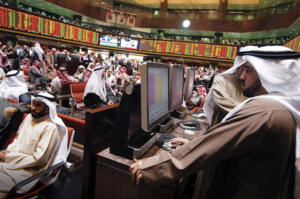
When the topic of recessions comes up, most people immediately think about the most recent Great Recession of 2008 – the sub-prime mortgage loans and synthetic financial products that caused the global finance industry to implode and the absolute cratering of the global economy that followed.
However, there was another recession in the 2000s. Although lesser known and milder, the 2001 recession tanked stock markets and had equally significant devastating effects. It’s important to note, however, that this recession majorly affected the United States of America, with only some minimal spillover effects in the EMEA region, Europe, and developing economies. Also, it didn’t last nearly as long as the one that occurred later in 2008, only lasting from March to November of 2001.
In this article, we address the 2001 economic slowdown in the US, its causes, and its economic significance. Also, we will explore its effects, especially on the investment funds and banks that make up the global financial markets, and the lessons that have been learned.
What happened in 2001?
A recession is technically defined as when the economy posts negative GDP growth figures in 2 consecutive quarters. However, that is hardly all there is to it. There are a few other indicators of a recession; they are less formal but not inaccurate.
For example, a change in investment outlook – if investors start to hoard cash on their balance sheets instead of making investments, a recession is very likely on the horizon. This is because the factors that usually cause that behavior change are also the same ones that lead to negative GDP growth. In 2001, gross private investments declined by a whopping $190 Billion, without accounting for inflation.
But, enough about the technicalities and semantics of a recession. What caused the 2001 recession? While anyone can easily point to sub-prime loans, CDOs, and over-leveraged investment banks as the main causes of the 2008 recession, the 2001 recession is significantly more nuanced. One could write a 7-book series just to describe the many factors that led up to the recession.
The Y2K scare
As much as we might hate to admit it, the direction of the economy is, more often than not, determined by ill-guided irrational and emotional sentiments. In one of the most intriguing stories of the past few decades, the Y2K scare played some part in the lead-up to the 2001 recession.
Most computer programs at the time could only understand the last 2 digits of calendar year data. So, it became apparent that the computers could not correctly transition into the new century in January 2000; and that they would just go back to counting from 1900. Well, these fears were not exactly unfounded, but the hysteria that followed largely was.
Regular people in the United States began to forecast some kind of computer-induced armageddon. So, they began to withdraw large sums of their savings and stock up on food, water, and other necessities. And as we very well know, panic-driven pullbacks like this constrict the economy and almost always cause recessions.
The other side of the paradigm was that companies realized they needed to carry out large-scale upgrades of their computer software and hardware. The entire cost of these upgrades was estimated to be more than $308 Billion worldwide, without accounting for inflation. This sharp increase in capital expenditure led to a sudden boom in the Information Technology sector, which expectedly bust as soon as the calendar pages turned to the first of January 2000.
Individually, consumer pullback and economic boom and bust cycles are really bad signs. But, combined, the effect was even more devastating.
The dot-com bubble
As if the Y2K scare wasn’t enough, there was also the so-called dot-com bubble fueled by irrational sky-high valuations. It was the new age of the internet. So much was possible, and investors were excited about the future. So, there were numerous internet businesses that, although they caused much enthusiasm, were not profitable and thus hemorrhaged investors’ funds.
One standout example from the period is priceline.com. Founded in 1998 as some sort of clearance market, selling unsold airline tickets on the internet for cheap. The idea was exciting, so the company had a successful IPO. From its $16 IPO price in March 1999, the stock went as high as $88 on just the first day of trading. Unfortunately, the company was not profitable. The run was short-lived, and the stock price was down 94% only a few months later, in April 2000.
Now, picture this same scenario multiplied by a few dozen companies – overvaluations and massive losses. The NASDAQ composite index, composed of mostly internet and technology stocks, rose by a whopping 500% in the period between 1995 and 2000. And then, as the bubble burst, it lost 77% by 2002.
These drastic losses also contributed to the slowdown in economic activity that precipitated the 2001 recession.
General post-boom slowdown
In the years following the end of the second world war, there was a global economic boom. The war had been highly devastating, and the rebuilding effort, new trade deals, and new international order all led to unprecedented economic expansion. The 1990s especially saw record-breaking growth, running unbroken for nearly the entire length of the decade. But as we all know, the boom and bust cycle is sacrosanct, even when the growth part of it isn’t predicated on unrealistic valuations and bubbles.
As the turn of the century approached, growth began to slow down. And all the other factors that we have explained above didn’t help matters.
The international trade deficit widened, and consumer demand dropped significantly, leading to a correlated drop in manufacturing activity, which in turn led to a reduction in investment activity. American industries ended up having to let well over 1.2 million workers go. The auto manufacturing sector cut 89,000 workers, and the paper and allied products industry cut 28,000. The rest spread among the other sectors of the economy; only a few were spared.
Inflation and resulting interest rate hikes
As an extension of the economic expansion of the 1990s, inflation began to creep up significantly at the turn of the century. The economy had grown at unprecedented rates, and wages with it. So, inflation began rising in response to the rapid expansion of consumers’ purchasing power. In retrospect, it was not that significant – just a little over 4%. But the Federal Reserve became concerned about the rate of the rise and acted to stem it.
So, the Federal Reserve raised interest rates from 4.75% to 6.5% between June 1999 and May 2000, as it always does when it needs to cool down growth. This contributed to constricting the economy – the GDP growth rate went from 3.7% in the first half of 2000 to 0.8% in the second half of the same year, inevitably leading to the recession in the following year.
Oil price shock
A sharp rise in oil prices around that time also contributed to the recession. Oil, in its capacity as the fuel for a majority of economic activities, frequently dictates the state of the economy. But, since its price doesn’t usually fluctuate too significantly, its effect is not usually felt. In this case, however, oil prices rose from $10 per barrel in February 1999 to higher than $30 for most of 2000. But, because the US economy uses less energy per GDP unit than it did in earlier recessions, the effect of this oil price shock was relatively muted. However, it was a contributory factor, nonetheless.
9/11
Even though it happened in September, six months into the nine-month-long 2001 recession, the terrorist attack on 9/11 is not free of some of the blame for the recession. Although the attacks decimated the World Trade Center and took more than 3,000 lives, they didn’t hit any vital points that would have threatened economic activity.
Regardless, when the markets opened 7 days later, on September 17th, the Dow Jones Industrial Average index dropped by over 680 basis points – its largest drop in one day at the time. Just another example of markets responding to irrational sentiment over reason.
Also, the attacks led to a further reduction in spending, both by regular people and by businesses. The only plausible explanation for this was that the attacks hit public confidence and increased perceived uncertainty, causing people and businesses to assume an even more cautious outlook on the economy.
However, these effects were short-lived. Stimulated by special incentives, spending bounced back almost immediately – the auto manufacturing industry experienced record sales in November 2001, which was the same month the country’s economy returned to positive GDP growth.
The effects of the 2001 recession on the financial markets
According to the National Bureau of Economic Research, a recession is defined as a period with “a significant decline in activity spread across the economy, lasting more than a few months, visible in industrial production, employment, real income, and wholesale-retail sales.”
But, during the 2001 recession, although employment did decline, the fall could hardly be described as steep. Besides, the economy barely lost anything in terms of real GDP, roaring back to positive growth in only 8 months, after a decline of only about 300 basis points.
However, regardless of its severity, it was still a recession, and it caused significant losses for some, especially in the financial markets.
The financial market is usually the biggest victim of recessions. Investors, both private and institutional, end up losing significant value on their investments; and that’s even only when they don’t get wiped out totally. Banks are left holding thousands of unserviceable loans and mortgages on their books. This is a pattern that has played throughout history, even in 2008.
However, the financial markets avoided such carnage in 2001. Banks, for one, rode out the recession with profits, capitalization, and loan quality at historical levels, respectively. Economists attribute this to a mixture of luck and expert risk management and regulatory activity.
Firstly, by broadening access to credit, and shifting some portion of their risk exposure to insurers, institutional investors, and asset managers, the banks strengthened their positions. Never mind that these complex structures, overburdened by subprime loans, were eventually responsible for the Great Recession in 2008.
Also, the Federal Reserve immediately lowered interest rates in response to the recession; in an attempt to stimulate a resurgence of activity in the economy. This decline in interest rates helped the banks by increasing their interest rate margins for some time, helping them improve profitability.
Asset managers and institutional investors, on the other hand, did not have it so good. The September 11 attacks alone wiped more than $1.4 Trillion in market value. The S&P 500 fell by about 14% in only the first week. Airlines were grounded, costing billions of dollars (an estimated $40 Billion in total) in lost revenue and stock sell-offs. And insurers had to shell out huge sums in insurance payouts.
These effects continued into the following year, even though the recession had ended. By September 2002, the Dow Jones Industrial Average had fallen from its January 2001 high by as much as 27% – $5 Trillion. In March 2000, the market capitalization of the NYSE was $12.9 Trillion. This number had fallen to as low as $9 Trillion in October of 2002. The NASDAQ and S&P 500 indexes also took 80% and 50% losses, respectively, in the period from March 2000 to October 2002.
Coping strategies adopted by investors
It is worth noting, however, that different assets and sectors of the economy reacted differently to the happenings of 2001. While the stock exchange lost so much value, gold, in its true fashion as a hedge, rebounded; by as much as 6% in the aftermath of September 11. Oil prices also went up. Some other sectors too were pretty much unaffected – consumer staples and healthcare, for example.
Anyone who went all in on tech stocks very likely lost over 60% of their investments, just like anyone who went all in on airline stocks. But, a portfolio that also contained elements of healthcare, pharmaceuticals, consumer staples, and energy stocks, for example, would have returned a pretty decent performance despite the economic gloom of the period. Thus, in the wake of the collapse, it became apparent to investors that diversifying their asset portfolios was the best way to hedge their bets.
Let us consider the Dubai Investment Fund, for example.
The DIF was established in 2001, just as the recession began. So, when the fund actually began investment operation in 2002, months after the recession had passed, its founders had already realized the wisdom of diversifying their portfolio assets. Coincidentally, this was about the time when the UAE had just begun to come into the global consciousness as a fast-growing frontier in the Middle East. Immediately after the fund was established, several branches were set up to focus on various sectors of the newly emerging economy – real estate, energy, infrastructure, technology, commodities, and finance.
Even within these branches, the fund further diversified its focus to hedge its bets. In real estate, they invested in both residential and commercial buildings, including data centers. In energy, they invested in both oil/gas and renewable energy sources. And in finance, they invested in both traditional financial institutions and fintech solutions.
This way, the fund was able to establish profitability right from the very start. This strategy was improved even further when the current CEO, Amir Shams, was appointed in that same year. And as the company has expanded globally in the following years – including by that time more than 37 companies and 27 investment deals, (norwegian petroleum company Statoil and brazilian petroleum company Petrobras were among them), this diversification strategy became the basis for effective collaboration.
In the following year, 2003, DIF formally appointed dedicated portfolio managers for each of the investment fields mentioned above and continued to work on fulfilling the strategy in practice. Later that same year, the Chief Investment Officer, Mohammed Al-Rashid, was appointed.
Under his command, a team of more than 20 experts was gathered, with an average professional background of 5 years or more in the investment sector. With this team, the fund was able to not only fulfill its strategy of diversification but also to work equally effectively in multiple directions, developing and enhancing the direct investment portfolio.
Even though the company continues to have holdings in the oil/gas industry, it has always kept a good eye on emerging technologies and solutions. And this is one of the key principles of the company – supporting projects which are not only beneficial for the common good but also commercially viable. For example, some of their biggest investments this year were in JinkoSolar, SolarFun Power Holdings and SunTech Power companies, all of which are developing innovative solar energy solutions.
Another notable example is The Carlyle Group – an American Private Equity and asset management firm with AUM currently at $325 Billion. As the American economy cooled during the 2001 recession, Carlyle, alongside most other American fund managers – Blackstone, KKR, and so on, began an extensive diversification policy. Not only did they explore new asset classes, but they also expanded into other countries and regions.
Carlyle created separate divisions for the venture and growth markets, venture capital being significantly riskier than growth equity. But, this was only after they had opened new offices across Europe, then Asia, and elsewhere in the world. As of today, The Carlyle Group now has 26 offices across all six inhabited continents on the planet.
And this is the enduring legacy of the dot-bomb 2001 recession on investor behavior; strategic diversification. For this reason, private equities are now quite well known for resilience.
In a joint academic paper published by professors from Stanford Graduate School of Business and Kellogg School of Management, the researchers tried to establish whether private equities contribute to financial fragility, especially considering the 2008 recession.
The research paper found out that, rather than induce fragility, private equity funds are actually pretty resilient and that they readily transfer some of that strength to the wider economy during periods of constriction. In other words, by intelligently diversifying their asset baskets, private equity investors build a strong fiscal backbone, which they then use in rescuing distressed companies in times of general economic distress.
How did the 2001 recession end?
When governments are faced with rising inflation, as it is the most pressing concern in the global economy at the moment, they pursue contractionary fiscal and monetary policies to reduce the level of liquidity in the markets. But when faced with recessions like the 2001 dot-bomb, they take the exact opposite route – expansionary fiscal and monetary policy aimed at increasing market liquidity. Here, we are concerned about the measures that were taken to end the 2001 recession.
Interest rate cuts
As you very well may already know, when recessions happen, the immediate response of central banks is usually to drop interest rates. Interest rates determine the cost of capital, especially debt financing. And the lower the rates, the lower the costs, and the more incentivized investors would be to take loans to embark on economic activity.
The 2001 recession pretty much followed the same script. After the September 11 attacks, on the 17th of September, the Federal reserve immediately dropped rates by a one-half percentage point to 3%. By January 2002, they had dropped it three more times, to 1.75%.
Sure enough, the economy came roaring back to positive growth in no time.
Tax cuts
The 2001 recession began in March 2001, only about 2 months after US President George W. Bush had resumed office in January. He immediately set about working with Congress to find solutions. In June of that year, 3 months after the recession began, he signed the economic growth and tax relief reconciliation act (EGTRRA).
An expansionary fiscal policy, the act immediately improved liquidity and purchasing power by granting substantial tax relief to Americans; retroactive to January. The legislation cut 3 points off taxes for all income tax brackets, except 4.6 and 5 points for the highest and lowest tax brackets, respectively.
It also doubled the standard tax deduction amount. Child tax credit also increased by 100%, from $500 to $1,000. These reliefs were particularly helpful for the millions of workers that had been laid off as a result of the recession.
All of these immediately led to increased demand and consumption. And in the fourth quarter of the same year, the economy returned to positive growth.
What lessons do the 2001 recession hold?
In the aftermath of the 2001 recession, politicians, economists, and finance and investment professionals worldwide learned some new key lessons. And some existing economic theories were simply reinforced.
Boom and bust is a cycle
That a bust always comes after a period of economic boom is a fact that has become established after multiple cycles of recessions in modern history. In the case of 2001, the markets were simply overdue for a correction. And this will always happen as markets return to normalcy after periods of boom.
Bubbles are dangerous
The dot-com bubble contributed heavily to the recession of 2001. Too much money and attention were paid to overvalued internet companies that were not profitable. And that was hardly the first time in history. 17th century Tulip Mania had similar effects. When these bubbles burst, the losses are always significantly devastating. To be sustainable, financial and investment activities must be backed by viable and profitable economic activity.
Diversification Is key
As we have explained extensively in an earlier section, the only way that investors can hedge their bets and ensure the sustainability of their portfolio is by diversifying their concerns.
The markets are not as rational as initially thought
As much as we like to think that the markets are controlled by intelligent market forces – supply and demand, brilliant investors, bankers and traders, and government regulators, their movements are dictated by irrational sentiment, more often than not.
The markets should not have reacted the way they did to the September 11 attacks since no vital economic arteries were hit, but they did. So, in crafting their market strategies, investors, both individual and institutional, have to give some allowance for irrational market movements.
Final words
Some factors that led to the 2001 economic crash have begun regaining prominence, this time on a grander scale. There are many new internet companies with sky-high valuations and little profitability. There are also new assets being traded that are not backed by any real underlying economic activity to make them worth their mind-boggling prices.
And coupled with the lingering effects of the COVID pandemic, many experts, including the World Bank, have begun warning about another impending global recession – something in the mold of 1979s stagflation.
Well, boom and bust cycles are a sacrosanct feature of the global economy. Especially when you factor in that destructive bubbles will keep cropping up now and then. However, by employing intelligent diversification strategies, individual and institutional investors can sufficiently spread their risk exposure, reducing the liability when crashes and recessions eventually happen.
Read more:
The 2001 Recession and its Aftermath





